Psoriasis Skin Disease May Lead to Heart Disease – Study Shows
[fair warning, this article contains some images that may not be for the faint of heart]
People with a rash and skin patch usually believe they have a simple allergy case on their hands. These breakouts which they call “allergies” begin to pile up in crusts and disrupt daily activities, worse, affect how you see yourself. This is typical of Psoriasis – a skin disease that you won’t notice until it actually grows on you. Worst case scenario you get a heart attack out of it. Can you imagine? How can a simple skin disease stop the beating of your heart?
Stop itching. Get to Thinking. Be Aware!
The HealthDay News reported a developing study which focuses on how the skin disorder of psoriasis is linked to generating heart disease in a person, particularly, erupting artery inflammation.
An investigatory study, headed by Dr. Nehal Mehta, senior clinical investigator of U.S. National Heart, Lung, and Blood Institute found that even the mildest form of psoriasis may increase a persons’ risk of stroke or heart attack [1].
“As the amount of psoriasis plaque increases, the amount of blood vessel inflammation increases,” reported by Mehta.
He also added that even just a single patch or plaque of psoriasis could be biologically active. This leads to the development of a low-form inflammation. With such inflammation, the blood vessel disease speeds up[1].
With that being said, he emphasized that people should really get to know what psoriasis is and get rid of the mentality that it is just a simple cosmetic disease [1].
Before reviewing the study, let us take you on a quick tour on the nature of Psoriasis.
The Skin Disease – PSORIASIS
The National Psoriasis Foundation defines Psoriasis as an autoimmune disease which result in red, raised, scaly patches appearing on your skin. This kind of rash doesn’t easily go away with simple over-the-counter medications [2].
How do you get it?
Psoriasis is associated with some serious health conditions, including: heart disease, diabetes and depression. But with its autoimmune nature, scientists have linked it to a person’s genes and immune system [3].
The flaring of such psoriatic patches are triggered by stress, infection, injury to the skin, medications (Lithium, Quinidine, Antimalarials, Inderal, Indomethacin), allergies, diet and even the weather[3]. These triggers result in the rapid turnover of skin cells resulting in the classical silver plaque like psoriasis lesion.
How popular is Psoriasis?
The National Psoriasis Foundation reports that Psoriasis usually develops between the ages of 15 to 35, however, can develop at any age. Children are not immune either, there is a 10% to 15% that a child will manifest before the age of 10 [3].
There is a 1.3% incidence of Psoriasis in the African-American population and a 2.5% incidence in the Caucasian population. Men and women develop psoriasis at an equal rates [3].
Worldwide view, psoriasis is known to affect 2% of the population [4].
Despite its small scope worldwide, you may be amazed to know that it has affected 250,000 people in the United States alone [5], accounting for 2.2% of the American population [6]. Psoriasis accounts 2.25 million annual ambulatory clinic visits [7].
Psoriasis in Pop Culture
 “Cara Delevingne kate moss mario testino (cropped)” by Walterlan Papetti – Own work. Licensed under CC BY-SA 4.0 via Commons.
“Cara Delevingne kate moss mario testino (cropped)” by Walterlan Papetti – Own work. Licensed under CC BY-SA 4.0 via Commons.
The stunning model and actress Cara Delevingne struggles with the management of her psoriasis and the high-pressure world of fashion. Delevingne told the Times of London, “People would put on gloves and not want to touch me because they thought it was, like, leprosy or something.” She once had to wake up at 3 a.m. before modeling in the Louis Vuitton show to have her patches covered with body paint. “It wasn’t a good time… it is a mental thing as well because if you hate yourself and your body and the way you look, it just gets worse and worse.” She is currently taking a break from modeling to help manage her flares.
Where does it grow?
Psoriasis manifests on knees, elbows or scalp areas, however can develop pretty much anywhere. Apart from the patches, other symptoms include stinging, burning and itching [1]. A more specific perspective on each body part is given below.
Causes fine, mild and slight scaling. However, a severe case can bring forth thick, crusted plaques which covers the entire scalp. Lesions can even extend beyond the hairline to the back of the neck, ears, and forehead.
Usually seen on eyebrows, skin between upper lip and nose, hairline and upper forehead. This type of psoriasis is treated carefully as skin on the face is considered to be the most sensitive.
- Psoriasis on the Hands, Nails and Feet
Causes swelling, blistering and cracking flares of skin in this area. Roughly half of the population of those with psoriasis in this area develop nail lesions and up to 80% develop psoriatic arthritis [1].
These lesions cause the most discomfort and irritation (e.g. under the breasts, armpits) [1].
- Psoriasis of the Genitalia
Inverse psoriasis are the most common type of lesions to develop in this area, however, other types of lesions can also cause symptoms, mostly in male genitalia. [1].
What Psoriasis do you have?
The National Psoriasis Foundation lists five types of psoriasis [1], described below:.
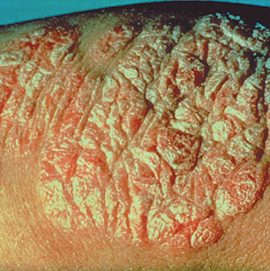
What?
This is most common form of Psoriasis. It is usually red in color & raised with patches of silvery white covering the skin. This buildup is the result of dead skin cells.
Where?
Such patches are commonly seen in the following areas: lower back, elbows, knees and scalp.
Feeling?
They are painful, itchy and usually crack up and bleed.
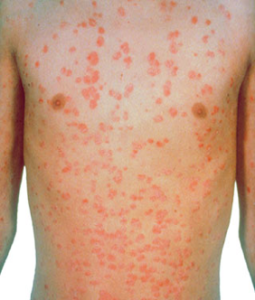
What?
Appears as small, dot-like, red lesions. Mostly seen in childhood to young adulthood and is the second most common type of psoriasis. Can be triggered by an upper respiratory infection or strep throat
Where?
All over the body.
Feeling?
Itchy.
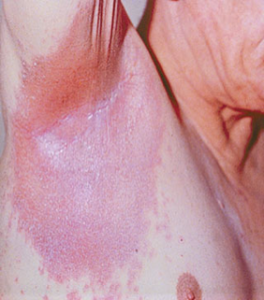
What?
Smooth,red and shiny . Usually manifests along with other types of psoriasis
Where?
This affects the skin folds –behind the knees, armpits, groin.
Feeling?
Itchy, sweaty and irritating.
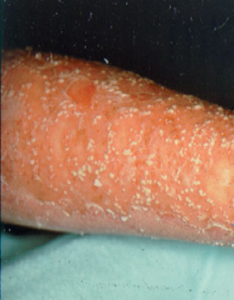
What?
White blisters with non-infectious pus.often surrounded by red skin. The white pus consist of white blood cells.
Where?
Most often seen on the hands or feet but can occur in any part on the body.
Feeling?
Itchy, rough
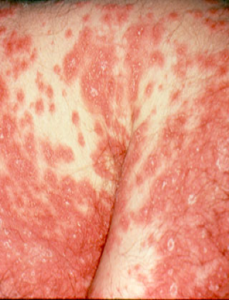
What?
Considered to be the most severe form of psoriasis. Occurs most commonly after episodes of plaque psoriasis. Quite rare, but occurs in at least 3% of people with psoriasis during their lifetime.
Where?
Widespread, distributing fiery redness
Feeling?
Severe itching and pain. Skin usually comes off in sheets.
How is it treated?
The National Psoriasis Foundation lists the approaches to management of Psoriasis, however each case of Psoriasis is managed differently depending on severity, location, age and type [8]. It’s best to work closely with your healthcare provider to develop an individualized treatment plan..
Systemics
Used in moderate to severe cases of psoriasis and psoriatic arthritis. Available in injectable and oral formulations.
Biologics
Used in cases of moderate to severe psoriasis and psoriatic arthritis unresponsive to other treatments. Only available in intravenous infusion or intramuscular injection. This treatment is usually derived from living sources.
New Oral Treatments
Oral medications such as Otezla have shown the greatest promise in managing moderate to severe psoriatic arthritis and Psoriasis by regulating inflammation within the cell. It inhibits an enzyme known as phosphodiesterase 4, or PDE4. PDE4 controls much of the inflammatory action within cells, which can affect the level of inflammation associated with psoriatic disease. Improves joint tenderness and swelling in people with active psoriatic arthritis, and can improve symptoms of redness and scaliness in people with psoriasis.
Topicals
Available in cream, ointment and lotion form. Used in mild and localized cases of psoriasis
Phototherapy
Involves exposing the skin to certain wavelengths of ultraviolet light under the supervision of a medical practitioner. Usually done in a psoriasis clinic, doctor’s office or even at home with a phototherapy unit.
The Complementary and Alternative
Involves techniques such as acupuncture, yoga, tai chi and herbal remedies to supplement traditional western medicine.
Is Psoriasis Contagious?
Psoriasis is never contagious. Plaques like lesions are considered non-infectious.
Whew! What a mouthful of information and surely, you would agree, that psoriasis is anything but a simple skin disease.
Psoriasis goes beyond skin deep and can result in inflammation of blood vessels (vasculitis)
Vasculitis – Inflammation of the blood vessels
Vasculitis, described, by the National Heart, Lung and Blood Institute, to be the condition of the inflammation in the blood vessels. Usually, this occurs because the immune system mistakenly attacks blood vessels, mistaking them for a “foreign invader”. As inflammation develops, swelling, warmth, redness, pain, and occlusion of blood vessels can manifest.
What it commonly affects?
By blood vessels that vasculitis affects include almost all. From arteries, veins, down to capillaries, the inflammation hinders their function. Your arteries carry oxygen-rich blood from the heart. The veins, on the other hand, carry oxygen-poor blood back to your beating heart. Capillaries bridge the two and allow for diffusion of oxygen.
What happens when they are inflamed?
The inflamed, narrowed blood vessel results in decreased blood flow to the affected organ – heart, brain, skin and can bring about a heart attack or stroke.
The Study
Several studies in the past have suggested an association between psoriasis and cardiovascular risk. Dr. Mehta and his team sought out to prove this association.
Dr. Mehta emphasizes the discovery between psoriasis and blood vessel inflammation is an association and never to be expected as a direct cause and effect to a person’s health condition. So, in order to give the association a deeper proof, Dr. Mehta and his team are conducting a study that would discover if treating psoriasis would aid in lowering the inflammation of a person’s blood vessels.
“Blood vessel, or vascular, inflammation is most likely the direct result of psoriasis, not treatment. Treating psoriasis may lower the risk of heart attack and stroke,” Mehta said.
A study was published in the journal of Arteriosclerosis, Thrombosis and Vascular Biology, supported the claim of Dr. Mehta, showing those with psoriasis have increased blood vessel inflammation as compared to those without.
The study grouped 80 people in their 40s with an average to low risk of heart disease. 60 of which were adults with psoriasis while 20 were without.. Those with psoriasis, the mild forms were described to have few patches covering 3% or less of their skin while those severe cases had patches which covered their skin by about 10% [10].
The researchers revealed that the participants with psoriasis were found to have increased levels of blood vessel inflammation – A 41% increased in blood vessel inflammation was seen in participants with psoriasis as compared to those without.
Such evidences suggests proper treatment of psoriasis may lower the risk of heart conditions. Even the research program director of the National Psoriasis Foundation, Michael Siegel believes so with this statement,
“Even mild psoriasis carries a risk for heart problem. Although it is not yet proven that treating psoriasis reduces the risk of heart attack and stroke, there is enough evidence to suggest that patients should have their disease treated.”
Hence, it is advisable that people with psoriasis should focus on changing few of their lifestyles. Mehta recommends that psoriasis patients should avoid smoking and try to incorporate a healthy lifestyle through moderate exercise and a healthy well-balanced diet. Comorbidities such as hypertension, diabetes, and elevated cholesterol should be controlled as well.
Now you have a clear preview on how managing such a “simple” disease condition can potentially protect you from having a graver disease condition. So, if you get a little itch or rash be sure to get checked out! You might actually save your life in the long run.
SOURCES:
- Nehal Mehta, M.D., clinical investigator, U.S. National Heart, Lung, and Blood Institute;
- National Psoriasis Foundation, About Psoriasis, online
- National Psoriasis Foundation, Causes and Triggers, online.
- Raychaudhuri SP, Farber EM. The prevalence of psoriasis in the world. J Eur Acad Dermatol Venereol. 2001;15:16–17. doi: 10.1046/j.1468-3083.2001.00192.x.
- Lebwohl M. Psoriasis. Lancet. 2003;361:1197–1204. doi: 10.1016/S0140-6736(03)12954-6.
- Stern RS, Nijsten T, Feldman SR, Margolis DJ, Rolstad T. Psoriasis is common, carries a substantial burden even when not extensive, and is associated with widespread treatment dissatisfaction. J Investig Dermatol Symp Proc. 2004;9:136–9. doi: 10.1046/j.1087-0024.2003.09102.x.
- Linden KG, Weinstein GD. Psoriasis: current perspectives with an emphasis on treatment. Am J Med.1999;107:595–605. doi: 10.1016/S0002-9343(99)00284-3.
- National Psoriasis Foundation, Treatments,
- National Heart, Lung and Blood Institute, Explore Vasculitis; Sept. 23, 2014, What is Vasculitis,
- Michael Siegel, Ph.D., director, research programs, National Psoriasis Foundation; Oct. 8, 2015,Arteriosclerosis, Thrombosis and Vascular Biology, online;


 “
“








 Human kidney magnification from a body as a medical diagram with a cross section of the inner organ with red and blue arteries and adrenal gland as a health care illustration of the anatomy of the urinary system.[/caption]
Human kidney magnification from a body as a medical diagram with a cross section of the inner organ with red and blue arteries and adrenal gland as a health care illustration of the anatomy of the urinary system.[/caption]

